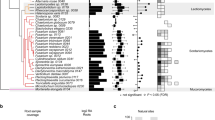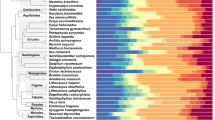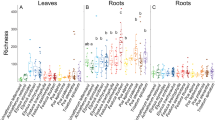Abstract
Plants associate through their roots with fungal assemblages that impact their abundance and productivity. Non-mycorrhizal endophytes constitute an important component of such fungal diversity, but their implication in ecosystem processes is little known. Using a selection of 128 root-endophytic strains, we defined functional groups based on their traits and plant interactions with potential to predict community assembly and symbiotic association processes. In vitro tests of the strains’ interactions with Arabidopsis thaliana, Microthlaspi erraticum and Hordeum vulgare showed a net negative effect of fungal colonization on plant growth. The effects partly depended on the phylogenetic affiliation of strains, but also varied considerably depending on the plant-strain combination. The variation was partly explained by fungal traits shared by different lineages, like growth rates or melanization. The origin of strains also affected their symbioses, with endophytes isolated from Microthlaspi spp. populations being more detrimental to M. erraticum than strains from other sources. Our findings suggest that plant–endophyte associations are subject to local processes of selection, in which particular combinations of symbionts are favored across landscapes. We also show that different common endophytic taxa have differential sets of traits found to affect interactions, hinting to a functional complementarity that can explain their frequent co-existence in natural communities.
Similar content being viewed by others
Log in or create a free account to read this content
Gain free access to this article, as well as selected content from this journal and more on nature.com
or
References
Aguilar-Trigueros CA, Hempel S, Powell JR, Anderson IC, Antonovics J, Bergmann J et al. (2015). Branching out: towards a trait-based understanding of fungal ecology. Fungal Biol Rev 29: 34–41.
Aguilar-Trigueros CA, Powell JR, Anderson IC, Antonovics J, Rillig MC . (2014). Ecological understanding of root-infecting fungi using trait-based approaches. Trends Plant Sci 19: 432–438.
Ali T, Schmuker A, Runge F, Solovyeva I, Nigrelli L, Paule J et al. (2016). Morphology, phylogeny, and taxonomy of Microthlaspi (Brassicaceae: Coluteocarpeae) and related genera. Taxon 65: 79–98.
Altschul SF, Madden TL, Schäffer AA, Zhang J, Zhang Z, Miller W et al. (1997). Gapped BLAST and PSI-BLAST: a new generation of protein database search programs. Nucleic Acids Res 25: 3389–3402.
Atsatt PR, Whiteside MD . (2014). Novel symbiotic protoplasts formed by endophytic fungi explain their hidden existence, lifestyle switching, and diversity within the plant kingdom. PLoS One 9: e95266.
Banhara A, Ding Y, Kühner R, Zuccaro A, Parniske M . (2015). Colonization of root cells and plant growth promotion by Piriformospora indica occurs independently of plant common symbiosis genes. Front Plant Sci 6: 667.
Basiewicz M, Weiß M, Kogel K-H, Langen G, Zorn H, Zuccaro A . (2012). Molecular and phenotypic characterization of Sebacina vermifera strains associated with orchids, and the description of Piriformospora williamsii sp. nov. Fungal Biol 116: 204–213.
Behie SW, Zelisko PM, Bidochka MJ . (2012). Endophytic insect-parasitic fungi translocate nitrogen directly from insects to plants. Science 336: 1576–1577.
Bever JD, Dickie IA, Facelli E, Facelli JM, Klironomos J, Moora M et al. (2010). Rooting theories of plant community ecology in microbial interactions. Trends Ecol Evol 25: 468–478.
Bever JD, Platt TG, Morton ER . (2012). Microbial population and community dynamics on plant roots and their feedbacks on plant communities. Annu Rev Microbiol 66: 265–283.
Blomberg SP, Garland T, Ives AR . (2003). Testing for phylogenetic signal in comparative data: behavioral traits are more labile. Evolution 57: 717–745.
Caldwell BA, Jumpponen A, Trappe JM . (2000). Utilization of major substrates by dark-septate, root endophytes. Mycologia 92: 230–232.
Carbonero F, Oakley BB, Purdy KJ . (2014). Metabolic flexibility as a major predictor of spatial distribution in microbial communities. PLoS One 9: e85105.
Castresana J . (2000). Selection of conserved blocks from multiple alignments for their use in phylogenetic analysis. Mol Biol Evol 17: 540–552.
Chagnon P-L, Bradley RL, Maherali H, Klironomos JN . (2013). A trait-based framework to understand life history of mycorrhizal fungi. Trends Plant Sci 18: 484–491.
Cheikh-Ali Z, Glynou K, Ali T, Ploch S, Kaiser M, Thines M et al. (2015). Diversity of exophillic acid derivatives in strains of an endophytic Exophiala sp. Phytochemistry 118: 83–93.
Cohen J . (1988) Statistical Power Analysis for the Behavioral Sciences. L. Erlbaum Associates: Hillsdale, NJ.
Coleman-Derr D, Desgarennes D, Fonseca-Garcia C, Gross S, Clingenpeel S, Woyke T et al. (2016). Plant compartment and biogeography affect microbiome composition in cultivated and native Agave species. New Phytol 209: 798–811.
Desdevises Y, Legendre P, Azouzi L, Morand S . (2003). Quantifying phylogenetically structured environmental variation. Evolution 57: 2647–2652.
Dufresne M, Osbourn AE . (2001). Definition of tissue-specific and general requirements for plant infection in a phytopathogenic fungus. Mol Plant Microbe Interact 14: 300–307.
Gardes M, Bruns TD . (1993). ITS primers with enhanced specificity for basidiomycetes—application to the identification of mycorrhizae and rusts. Mol Ecol 2: 113–118.
Glynou K, Ali T, Buch A-K, Haghi Kia S, Ploch S, Xia X et al. (2016). The local environment determines the assembly of root endophytic fungi at a continental scale. Environ Microbiol 18: 2418–2434.
Hallmann J, Berg G, Schulz B . (2006) Isolation procedures for endophytic microorganisms. In: Schulz BJE, Boyle CJC, Sieber TN (eds). Microbial Root Endophytes, Soil Biology. Springer Berlin: Heidelberg, Germany, 299–319.
Hiruma K, Gerlach N, Sacristán S, Nakano RT, Hacquard S, Kracher B et al. (2016). Root endophyte Colletotrichum tofieldiae confers plant fitness benefits that are phosphate status dependent. Cell 165: 464–474.
Hoeksema JD, Thompson JN . (2007). Geographic structure in a widespread plant–mycorrhizal interaction: pines and false truffles. J Evol Biol 20: 1148–1163.
Huelsenbeck JP, Ronquist F . (2001). MRBAYES: bayesian inference of phylogenetic trees. Bioinformatics 17: 754–755.
Ives AR, Midford PE, Garland T . (2007). Within-species variation and measurement error in phylogenetic comparative methods. Sys Biol 56: 252–270.
Johnsen HR, Krause K . (2014). Cellulase activity screening using pure carboxymethylcellulose: application to soluble cellulolytic samples and to plant tissue prints. Int J Mol Sci 15: 830–838.
Jumpponen A, Trappe JM . (1998). Dark septate endophytes: a review of facultative biotrophic root-colonizing fungi. New Phytol 140: 295–310.
Katoh K, Standley DM . (2013). MAFFT multiple sequence alignment software version 7: improvements in performance and usability. Mol Biol Evol 30: 772–780.
Keim J, Mishra B, Sharma R, Ploch S, Thines M . (2014). Root-associated fungi of Arabidopsis thaliana and Microthlaspi perfoliatum. Fungal Divers 66: 99–111.
Klironomos JN . (2003). Variation in plant response to native and exotic arbuscular mycorrhizal fungi. Ecology 84: 2292–2301.
Kõljalg U, Nilsson RH, Abarenkov K, Tedersoo L, Taylor AFS, Bahram M et al. (2013). Towards a unified paradigm for sequence-based identification of fungi. Mol Ecol 22: 5271–5277.
Knapp DG, Pintye A, Kovács GM . (2012). The dark side is not fastidious—dark septate endophytic fungi of native and invasive plants of semiarid sandy areas. PLoS One 7: e32570.
Lahrmann U, Strehmel N, Langen G, Frerigmann H, Leson L, Ding Y et al. (2015). Mutualistic root endophytism is not associated with the reduction of saprotrophic traits and requires a noncompromised plant innate immunity. New Phytol 207: 841–857.
Legendre P, Legendre LFJ . (2012) Numerical Ecology, Vol 24. 3rd edn, Elsevier: Amsterdam, Netherlands.
Maciá-Vicente JG, Ferraro V, Burruano S, Lopez-Llorca LV . (2012). Fungal assemblages associated with roots of halophytic and non-halophytic plant species vary differentially along a salinity gradient. Microb Ecol 64: 668–679.
Maciá-Vicente JG, Jansson H-B, Abdullah SK, Descals E, Salinas J, Lopez-Llorca LV . (2008a). Fungal root endophytes from natural vegetation in Mediterranean environments with special reference to Fusarium spp. FEMS Microbiol Ecol 64: 90–105.
Maciá-Vicente JG, Jansson H-B, Mendgen K, Lopez-Llorca LV . (2008b). Colonization of barley roots by endophytic fungi and their reduction of take-all caused by Gaeumannomyces graminis var. tritici. Can J Microbiol 54: 600–609.
Maciá-Vicente JG, Jansson H-B, Talbot NJ, Lopez-Llorca LV . (2009a). Real-time PCR quantification and live-cell imaging of endophytic colonization of barley (Hordeum vulgare roots by Fusarium equiseti and Pochonia chlamydosporia. New Phytol 182: 213–228.
Maciá-Vicente JG, Rosso LC, Ciancio A, Jansson H-B, Lopez-Llorca LV . (2009b). Colonisation of barley roots by endophytic Fusarium equiseti and Pochonia chlamydosporia: effects on plant growth and disease. Ann Appl Biol 155: 391–401.
Maherali H, Klironomos JN . (2007). Influence of phylogeny on fungal community assembly and ecosystem functioning. Science 316: 1746–1748.
Maherali H, Klironomos JN . (2012). Phylogenetic and trait-based assembly of arbuscular mycorrhizal fungal communities. PLoS One 7: e36695.
Ma L-J, van der Does HC, Borkovich KA, Coleman JJ, Daboussi M-J, Di Pietro A et al. (2010). Comparative genomics reveals mobile pathogenicity chromosomes in Fusarium. Nature 464: 367–373.
Mandyam K, Jumpponen A . (2005). Seeking the elusive function of the root-colonising dark septate endophytic fungi. Stud Mycol 53: 173–189.
Mandyam K, Jumpponen A . (2014) Unraveling the dark septate endophyte functions: insights from the Arabidopsis model. In: Verma VC, Gange AC (eds), Advances in Endophytic Research. Springer: India, 115–141.
Mandyam K, Jumpponen A . (2015). Mutualism–parasitism paradigm synthesized from results of root-endophyte models. Front Microbiol 5: 776.
Mandyam K, Loughin T, Jumpponen A . (2010). Isolation and morphological and metabolic characterization of common endophytes in annually burned tallgrass prairie. Mycologia 102: 813–821.
Mangan SA, Schnitzer SA, Herre EA, Mack KML, Valencia MC, Sanchez EI et al. (2010). Negative plant-soil feedback predicts tree-species relative abundance in a tropical forest. Nature 466: 752–755.
Mayerhofer MS, Kernaghan G, Harper KA . (2012). The effects of fungal root endophytes on plant growth: a meta-analysis. Mycorrhiza 23: 119–128.
Moles AT, Ackerly DD, Webb CO, Tweddle JC, Dickie JB, Westoby M . (2005). A brief history of seed size. Science 307: 576–580.
Murashige T, Skoog F . (1962). A revised medium for rapid growth and bio assays with tobacco tissue cultures. Physiol Plant 15: 473–497.
Newsham KK . (2011). A meta-analysis of plant responses to dark septate root endophytes. New Phytol 190: 783–793.
Oksanen J, Blanchet FG, Kindt R, Legendre P, Minchin PR, O’Hara RB et al. (2015). vegan: Community Ecology Package. Available from http://CRAN.R-project.org/package=vegan.
Orme D, Freckleton R, Thomas G, Petzoldt T, Fritz S, Isaac N . (2011) caper: Comparative Analyses of Phylogenetics and Evolution in R. Available from http://CRAN.R-project.org/package=caper.
Pagel M . (1999). Inferring the historical patterns of biological evolution. Nature 401: 877–884.
Peterson RL, Wagg C, Pautler M . (2008). Associations between microfungal endophytes and roots: do structural features indicate function? Botany 86: 445–456.
Piculell BJ, Hoeksema JD, Thompson JN . (2008). Interactions of biotic and abiotic environmental factors in an ectomycorrhizal symbiosis, and the potential for selection mosaics. BMC Biol 6: 23.
Powell JR, Parrent JL, Hart MM, Klironomos JN, Rillig MC, Maherali H . (2009). Phylogenetic trait conservatism and the evolution of functional trade-offs in arbuscular mycorrhizal fungi. Proc R Soc Lond B Biol Sci 276: 4237–4245.
R Core Team. (2013) R: A Language and Environment for Statistical Computing. R Foundation for Statistical Computing: Vienna, Austria.
Redecker D, Hijri M, Dulieu H, Sanders IR . (1999). Phylogenetic analysis of a dataset of fungal 5.8 S rDNA sequences shows that highly divergent copies of internal transcribed spacers reported from Scutellospora castanea are of ascomycete origin. Fungal Genet Biol 28: 238–244.
Revell LJ . (2011). phytools: an R package for phylogenetic comparative biology (and other things). Methods Ecol Evol 3: 217–223.
Rodriguez RJ, Henson J, Van Volkenburgh E, Hoy M, Wright L, Beckwith F et al. (2008). Stress tolerance in plants via habitat-adapted symbiosis. ISME J 2: 404–416.
Rodriguez RJ, White JF Jr, Arnold AE, Redman RS . (2009). Fungal endophytes: diversity and functional roles. New Phytol 182: 314–330.
Sacristán S, García-Arenal F . (2008). The evolution of virulence and pathogenicity in plant pathogen populations. Mol Plant Pathol 9: 369–384.
Sánchez Márquez S, Bills G, Herrero N, Zabalgogeazcoa I . (2012). Non-systemic fungal endophytes of grasses. Fungal Ecol 5: 289–297.
Schloss PD, Westcott SL, Ryabin T, Hall JR, Hartmann M, Hollister EB et al. (2009). Introducing mothur: open-source, platform-independent, community-supported software for describing and comparing microbial communities. Appl Environ Microbiol 75: 7537–7541.
Sieber TN, Grünig CR . (2013) Fungal root endophytes. In: Plant Roots—The Hidden Half. CRC Press, Taylor & Francis Group: Boca Raton, FL, USA, 38-1–38-49.
Sperschneider J, Gardiner DM, Thatcher LF, Lyons R, Singh KB, Manners JM et al. (2015). Genome-wide analysis in three Fusarium pathogens identifies rapidly evolving chromosomes and genes associated with pathogenicity. Genome Biol Evol 7: 1613–1627.
Symonds MRE, Blomberg SP . (2014) A primer on phylogenetic generalised least squares. In : Garamszegi LZ (ed), Modern Phylogenetic Comparative Methods and Their Application in Evolutionary Biology. Springer Berlin: Heidelberg, Germany, 105–130.
Tellenbach C, Grünig CR, Sieber TN . (2011). Negative effects on survival and performance of Norway spruce seedlings colonized by dark septate root endophytes are primarily isolate-dependent. Environ Microbiol 13: 2508–2517.
Thompson JN . (2005) The Geographic Mosaic of Coevolution. University of Chicago Press: Chicago, IL.
Torchiano M . (2015) effsize: Efficient Effect Size Computation. Available from http://CRAN.R-project.org/package=effsize.
Treseder KK, Lennon JT . (2015). Fungal traits that drive ecosystem dynamics on land. Microbiology and Mol Biol Rev 79: 243–262.
Usuki F, Narisawa K . (2007). A mutualistic symbiosis between a dark septate endophytic fungus, Heteroconium chaetospira, and a nonmycorrhizal plant, Chinese cabbage. Mycologia 99: 175–184.
Vandenkoornhuyse P, Baldauf SL, Leyval C, Straczek J, Young JPW . (2002). Extensive fungal diversity in plant roots. Science 295: 2051–2051.
Van der Putten WH, Van Dijk C, Peters BAM . (1993). Plant-specific soil-borne diseases contribute to succession in foredune vegetation. Nature 362: 53–56.
Violle C, Jiang L . (2009). Towards a trait-based quantification of species niche. J Plant Ecol 2: 87–93.
Violle C, Navas M-L, Vile D, Kazakou E, Fortunel C, Hummel I et al. (2007). Let the concept of trait be functional!. Oikos 116: 882–892.
Wang Q, Garrity GM, Tiedje JM, Cole JR . (2007). Naive bayesian classifier for rapid assignment of rRNA sequences into the new bacterial taxonomy. Appl Environ Microbiol 73: 5261–5267.
Wardle DA, Bardgett RD, Klironomos JN, Setälä H, van der Putten WH, Wall DH . (2004). Ecological linkages between aboveground and belowground biota. Science 304: 1629–1633.
Webb CO, Ackerly DD, Kembel SW . (2008). Phylocom: software for the analysis of community phylogenetic structure and trait evolution. Bioinformatics 24: 2098–2100.
Wehner J, Powell JR, Muller LAH, Caruso T, Veresoglou SD, Hempel S et al. (2014). Determinants of root-associated fungal communities within Asteraceae in a semi-arid grassland. J Ecol 102: 425–436.
White TJ, Bruns T, Lee S, Taylor J . (1990) Amplification and direct sequencing of fungal ribosomal RNA genes for phylogenetics. In: Innis MA, Gelfand DH, Sninsky JJ, Tj White (eds), PCR Protocols: a Guide to Methods and Applications. Academic Press: San Diego, CA, USA, pp 315–322.
Zavala-Gonzalez EA, Escudero N, Lopez-Moya F, Aranda-Martinez A, Exposito A, Ricaño-Rodríguez J et al. (2015). Some isolates of the nematophagous fungus Pochonia chlamydosporia promote root growth and reduce flowering time of tomato. Ann Appl Biol 166: 472–483.
Acknowledgements
We thank Johanna A Bac-Molenaar, Xiaojuan Xia and Saatzucht Josef Breun GmbH & Co. KG for kindly providing seeds of A. thaliana, M. erraticum and barley cv. Barke, respectively. We also thank Gábor M Kovács and three anonymous referees for their constructive comments on this manuscript. This study was supported by LOEWE (Landes-Offensive zur Entwicklung Wissenschaftlich-ökonomischer Exzellenz) of the state of Hesse and was conducted within the framework of the Cluster for Integrative Fungal Research (IPF).
Author information
Authors and Affiliations
Corresponding author
Ethics declarations
Competing interests
The authors declare no conflict of interest.
Additional information
Supplementary Information accompanies this paper on The ISME Journal website
Rights and permissions
About this article
Cite this article
Kia, S., Glynou, K., Nau, T. et al. Influence of phylogenetic conservatism and trait convergence on the interactions between fungal root endophytes and plants. ISME J 11, 777–790 (2017). https://doi.org/10.1038/ismej.2016.140
Received:
Revised:
Accepted:
Published:
Issue date:
DOI: https://doi.org/10.1038/ismej.2016.140
This article is cited by
-
Contrasting patterns in phylogenetic and biogeographic factories of invasive grasses (Poaceae) across the globe
npj Biodiversity (2023)
-
A fungal sesquiterpene biosynthesis gene cluster critical for mutualist-pathogen transition in Colletotrichum tofieldiae
Nature Communications (2023)
-
Genetic determinants of endophytism in the Arabidopsis root mycobiome
Nature Communications (2021)
-
Brassicaceous roots as an unexpected diversity hot-spot of helotialean endophytes
IMA Fungus (2020)
-
VBA–AMF: A VBA Program Based on the Magnified Intersections Method for Quantitative Recording of Root Colonization by Arbuscular Mycorrhizal Fungi
Indian Journal of Microbiology (2020)



